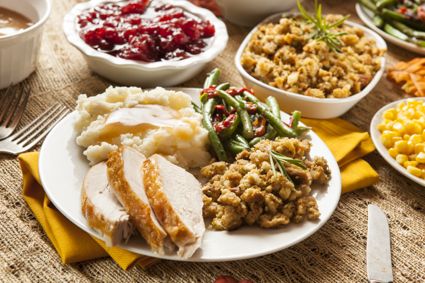Guest Blogger: Pilar Cobb, owner bFit Studio
Tips to Prevent the Holiday Bulge
‘Tis the season for holiday feasts, a calendar packed with holiday parties, and weather that can diminish our motivation to train. In November and December we’re faced with every culinary temptation imaginable, which makes it difficult to maintain peak fitness.
In fact, it’s common for some to pack on five to 10 pounds of body fat onto their normally “cut” athletic bodies during the holiday season, which can compromise performance at winter races and make for a slow return to peak form in the spring.
Fortunately, the situation is far from hopeless. It’s possible to enjoy all the festivities–including the special foods that help make the season so enjoyable. Read on to learn about 10 nutrition and fitness strategies that will help you maintain peak fitness during the holiday season.
1. Eat four to six smaller meals rather than “saving” yourself for that special holiday meal
Do you honestly think you can resist the smell of a holiday kitchen when you’re starving? Chances aren’t too favorable. Not only do smaller, more frequent meals enhance metabolic activity (meaning you burn more calories during the day), your less likely to binge on those holiday treats.
To help curb your appetite before a party, choose to snack on “heavy” foods or those that contain a high water content like broth-based soups, fruits and vegetables. Appetite-control researchers have found that your brain may monitor how much you eat based on the weight of your food. One study discovered that people automatically stop eating when they consume a particular weight of food, regardless of the amount of fat or calories.
If the food was light, but high in calories, study participants could easily consume 1,000 calories without feeling satisfied. But they stopped eating heavier low-calorie foods after just a few hundred calories. For example, for 300 calories, you could either have a couple handfuls of chips or five oranges. So instead of eating lightweight foods like chips, crackers, rice cakes and popcorn to curb your appetite, choose heavier foods like fruits and vegetables.
2. Plan a workout before a holiday party or big meal
Why not use all those scrumptious holiday foods as recovery from a hard run or bicycle ride? In the one or two hours after intense exercise, our bodies are more sensitive to the hormone insulin, which helps transport sugars to our depleted muscles. All those precious carbohydrates found in starchy holiday dishes like mashed potatoes, or sugars found in cranberry sauce or pumpkin pie are excellent for glycogen replenishment. And the protein you’ll get from that holiday turkey meal will help repair damaged tissue. Furthermore, our metabolism is heightened after a hard effort, meaning we’re more effective at burning those little “indulgences” that may otherwise pack on the unwanted weight for upcoming training.
3. In contrast to our “sports mentality” to pick up the pace, when eating, SLOW DOWN!
If you’re competitive by nature, you may be inclined to “hurry” your meals. Unfortunately, you won’t win a medal by eating fast and you’ll make it even harder to win one at your next race with those additional pounds slowing your pace. It takes at least 20 minutes for our brains to signal that we’re actually full, which means a slow eater will consume less calories before feeling full than someone who races through their meal. So rather than attempting to finish your plate first, see if you can outlast the competition by being the last to finish.
4. Remember the law of diminishing returns
Doesn’t the first bite always taste the best? When looking at brain chemicals signaling “pleasure,” scientists have found that we receive less pleasure the more we eat of a food. So rather than feeling like you must eat a full serving of every dessert at a holiday meal, take a bite or two and receive 90 percent of the pleasure at 10 percent of the calories.
5. Take advantage of “nutritionally dense” holiday foods
Perhaps you’ve never thought of traditional holiday foods as a nutritional gift. You may have considered those 10 pounds you gained from holiday eating more of a nutritional wake-up call than a gift. Fortunately, many holiday food staples can supply our bodies with a multitude of health-enhancing nutrients and when consumed in moderation, can actually become year-round nutritional staples. So during this holiday season, be sure to include these health enhancing foods:
Pumpkin.
You can eat that scrumptious pumpkin pie without all the guilt! Pumpkin is an excellent source of beta-carotene (269 percent RDA per half-cup serving), which is converted to resistance-building vitamin A. Pumpkin is also a wonderful source of iron (17 percent RDA per half-cup serving), a mineral essential for transporting oxygen to our working cells. And surprisingly, canned pumpkin contains 15 times more beta-carotene than fresh pumpkin. Reduce the fat content of pumpkin pie by using egg substitute and evaporated skim milk instead of whole eggs and cream, and replace the traditional pastry crust with crushed ginger snap cookies or graham crackers instead.
Cranberries.
Cranberries are a fruit for all seasons, although they’re more apparent during the holidays. The cranberry’s plant pigment that provides color to our holiday plate also provides a number of compounds that have shown early promise against cancer and heart disease. The ellagic acid in cranberries has been shown to help prevent tumor growth by disarming cancer-causing agents. In addition, cranberries contain two powerful flavonoids–quercetin and myricetin–that have been shown to prevent damage to blood vessel linings, thereby playing a role in the prevention of artery disease. Because cranberries are tart when eaten alone, many cranberry sauce recipes call for a lot of sugar. Generally, reducing the sugar content by 25 percent still yields a tasty product. Many diabetics have used the sweetener Splenda (sucrolose) instead of sugar with great success. Splenda is stable for cooking and baking and measures just like sugar, without the added calories.
Turkey.
Since the pilgrims’ first Thanksgiving feast, turkey has been a staple protein source. Turkey also provides significant sources of B-vitamins, selenium and zinc, nutrients essential for optimal nerve and immune function. Skip the outer skin and you’ll avoid most of the fat. While white meat (turkey breast) is generally considered the most nutritious part of the bird with its low fat content, darker meat contains 10 percent more iron per three-ounce serving. When selecting a turkey, choose fresh, unbaked rather than pre-basted–these are injected with an oil and salty broth mixture. You can baste the turkey with broth, sherry or white wine rather than butter to further reduce the fat content.
Sweet Potatoes.
Despite an impressive nutritional profile and sweet flavor, sweet potato consumption has gone down instead of up. A four-ounce sweet potato contains a mere 143 calories and provides over 100 percent of our daily needs for beta-carotene. It also provides more than a quarter of our daily needs for vitamins C and E–nutrients that have been shown to help protect cell damage in athletes competing in extreme environments (e.g., altitude, heat, cold, pollution), as well as enhance muscle recovery after intense running efforts. In addition, sweet potatoes are an excellent source of iron, a nutrient commonly lacking in vegetarian athletes. So expand your intake of sweet potatoes beyond the traditional Thanksgiving casserole: Add sweet potatoes to chili or your favorite potato salad recipe; shred it raw into hamburger, meatloaf and meatball mixtures; toss chunks of it into salads; or use mashed sweet potato as ravioli stuffing.
Chestnuts.
“Chestnuts roasting on an open fire” provide quite the nutritional punch. In contrast to other calorie- and fat-laden nuts, chestnuts contain less than one gram of fat per ounce, while providing a hefty dose of fiber (3.7 grams), vitamin C (12 percent RDA), and folic acid (10 percent RDA)–nutrients important for immune function, formation of collagen and reduced risk for cardiovascular disease. Chestnuts are good in stuffing, pilaf, vegetable side dishes and soups. They’re also excellent snacks by themselves.
6. Offer to bring a healthy dish to holiday parties
If you’re concerned about the unhealthy array of foods that are bound to be served at an upcoming function, call the host ahead of time to see if you can bring a healthy dish. Chances are, the host will be happy to have some help with the overwhelming task of pleasing a hungry crowd!
For appetizers, you could bring a vegetable platter with low-fat dip; a colorful fruit platter with a dip made from nonfat yogurt blended with a dab of fat-free cool whip garnished with roasted chestnuts; whole wheat pita triangles served with hummus; or baked tortilla chips with chunky salsa and/or fat-free refried bean dip.
7. Try recipe modification
Many people fret about a cooking disaster when preparing a large meal during the holidays and therefore don’t want to experiment with new ingredients. But often times these new ingredients enhance both the nutritional value and the flavor of the dish.
For example, I prepared a batch of muffins using a traditional recipe with oil and another batch substituting applesauce for the oil. Of course the recipe modification enhanced the nutritional value of the muffins, but the tasters actually rated the flavor and overall satisfaction of the modified muffin recipe higher than the traditional recipe.
So, making modifications of your favorite recipes can make the dish healthier, and perhaps even tastier. To avoid a potential cooking disaster, you can always practice the modified recipe before the big day!
8. Beware of liquid calories, especially alcohol
Be careful, those liquid calories can add up quickly (see Table 1). Alcohol actually contains almost as many calories per gram as fat (seven calories vs. nine calories per gram). Combine the alcohol with creamy or sweet mixtures, and you get even more calories. Alcohol also tends to lower our inhibitions, which means you’ll be less careful about what and how much you indulge at the party. So instead of reaching for the bubbly, rotate a non-caloric drink like diet soda, water or spritzer into the mix. That way you’ll be able to allocate more of your calorie budget on the delicious holiday foods you enjoy.
Table 1: Calories Found in Alcoholic Beverages
| Beverage | Serving size | Calories |
| Beer | 12 ounces | 160 |
| Light Beer | 12 ounces | 100 |
| Non-alcoholic Beer | 12 ounces | 32 |
| Red Wine | 4 ounces | 85 |
| White Wine | 4 ounces | 80 |
| Wine Cooler | 8 ounces | 120 |
| Daiquiri | 4 ounces | 225 |
| Margarita | 4 ounces | 270 |
| Gin and tonic | 4 ounces | 150 |
| Pina colada | 4 ounces | 262 |
9. Don’t “hang out” at the appetizer table when socializing at a party
It’s hard to believe how much those small handfuls of munchies add up at a party. I observed a stranger’s eating habits while socializing at a holiday party to see what kind of calories we’re capable of consuming before the holiday meal. The following appetizers were consumed in the two hours before the meal:
4 rye crackers with ~1/2 ounce of soft cheese
3 bunches of grapes
3 handfuls of mixed nuts
2 glasses of wine
1 handful M&Ms with nuts
2 pieces broccoli with ~1 Tbsp cream cheese dip
Total: 1,209 calories, 60 g fat, 28 g protein, 110 g carbohydrate
This adds up, especially when you consider these totals make up approximately half the total daily calories needed by the average active person. In my observation, it appeared that people who were socializing away from the appetizer tables were less apt to subconsciously pick at the food. Instead, they filled one small plate of food and then called it quits. Make a conscious effort to position yourself away from the hors d’oeuvres at a holiday function.
10. Use a journal to monitor your training and nutrition
One of the best ways to track your fitness program is with a training log, and the same holds true for your food intake. I’ve found that my most successful clients are those who actually take the time to monitor both their training and food intake in a daily log. It not only makes you accountable to yourself on a daily basis, but it’s also a great way to develop nutritional goals for yourself and determine which eating patterns improve your energy levels and help enhance your overall performance.
Above all, don’t punish yourself if you do tend to overindulge at a holiday function. Chances are those extra calories will serve as fuel for your next activity. If you try starving yourself to compensate, you’ll most likely overcompensate on some of the less-healthy indulgences that are readily available during the holidays. Rather than fretting about food, learn to focus on the social aspects of this special time of year, enjoying the company of friends and family.
Pilar Cobb, NASM/ACE Certified Personal Trainer
Certified Fitness Nutrition Specialist
Owner, bFit Studio
www.bfitcolumbus.com



